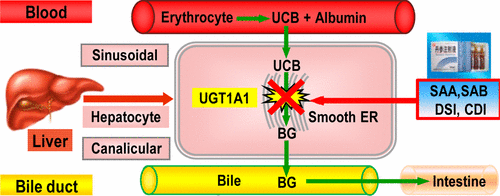当前位置:
X-MOL 学术
›
Mol. Pharmaceutics
›
论文详情
Our official English website, www.x-mol.net, welcomes your
feedback! (Note: you will need to create a separate account there.)
Inhibition of Human UGT1A1-Mediated Bilirubin Glucuronidation by Polyphenolic Acids Impact Safety of Popular Salvianolic Acid A/B-Containing Drugs and Herbal Products
Molecular Pharmaceutics ( IF 4.5 ) Pub Date : 2017-06-22 00:00:00 , DOI: 10.1021/acs.molpharmaceut.7b00365
Guo Ma 1 , Ying Zhang 1 , Wenyan Chen 1 , Zhifang Tang 1 , Xiaoming Xin 1 , Ping Yang 1 , Xiaoqin Liu 1 , Weimin Cai 1 , Ming Hu 2
Molecular Pharmaceutics ( IF 4.5 ) Pub Date : 2017-06-22 00:00:00 , DOI: 10.1021/acs.molpharmaceut.7b00365
Guo Ma 1 , Ying Zhang 1 , Wenyan Chen 1 , Zhifang Tang 1 , Xiaoming Xin 1 , Ping Yang 1 , Xiaoqin Liu 1 , Weimin Cai 1 , Ming Hu 2
Affiliation

|
Bilirubin-related adverse reactions (ADR, e.g., jaundice and hyperbilirubinemia) induced by herbs rich in certain polyphenolic acids are widely reported. However, the causes and the mechanisms underlying these ADR are not well understood. The purpose of this article is to determine the mechanism by which certain polyphenolic acids inhibit UGT1A1-mediated bilirubin glucuronidation, leading to jaundice or hyperbilirubinemia. We investigated in vitro inhibitory effects on bilirubin glucuronidation of salvianolic acid A (SAA), salvianolic acid B (SAB), danshensu (DSS), protocatechuic aldehyde (PA), and rosmarinic acid (RA), as well as two Salvia miltiorrhiza injections (DSI and CDI) rich in polyphenolic acids. The results showed that average formation rates of three bilirubin glucuronides displayed a significant difference (p < 0.05) and the formation of monoglucuronide was favored regardless if an inhibitor was present or not. SAA, SAB, DSI, and CDI, but not DSS, PA, and RA, significantly inhibited human UGT1A1-mediated bilirubin glucuronidation via a mixed-type inhibitory mechanism. Average IC50 values of SAA, SAB, DSI, and CDI-mediated inhibition of bilirubin glucuronidation were bilirubin concentration-dependent, and their values (against total bilirubin glucuronidation) were in the range 0.44 ± 0.02 to 0.86 ± 0.04 μg/mL (for SAA), 4.22 ± 0.30 to 12.50 ± 0.93 μg/mL (for SAB), 9.29 ± 0.76 to 18.82 ± 0.63 μg/mL (for DSI), and 9.18 ± 2.00 to 22.36 ± 1.39 μg/mL (for CDI), respectively. In conclusion, SAA and its analog SAB are the main ingredients responsible for inhibition of bilirubin glucuronidation by DSI and CDI, whose use is associated with many high bilirubin-related ADR.
中文翻译:

多酚酸对人UGT1A1介导的胆红素葡萄糖醛酸苷化的抑制作用影响流行的含丹酚酸A / B的药物和草药的安全性
富含某些多酚酸的草药引起的胆红素相关不良反应(ADR,例如黄疸和高胆红素血症)被广泛报道。但是,这些ADR的原因和机制尚不十分清楚。本文的目的是确定某些多酚酸抑制UGT1A1介导的胆红素葡萄糖醛酸化机制,从而导致黄疸或高胆红素血症的机制。我们研究了对丹酚酸A(SAA),丹酚酸B(SAB),丹参素(DSS),原儿茶醛(PA)和迷迭香酸(RA)以及两种丹参丹参中胆红素葡萄糖醛酸苷的体外抑制作用富含多酚酸的注射剂(DSI和CDI)。结果表明,三种胆红素葡糖醛酸内酯的平均形成率均显示出显着差异(p <0.05),无论是否存在抑制剂,均有利于单葡糖醛酸内酯的形成。SAA,SAB,DSI和CDI而非DSS,PA和RA通过混合型抑制机制显着抑制人UGT1A1介导的胆红素葡萄糖醛酸苷化。平均IC 50SAA,SAB,DSI和CDI介导的胆红素葡萄糖醛酸化抑制值取决于胆红素浓度,其值(相对于总胆红素葡萄糖醛酸化)在0.44±0.02至0.86±0.04μg/ mL范围内(对于SAA),分别为4.22±0.30至12.50±0.93μg/ mL(对于SAB),9.29±0.76至18.82±0.63μg/ mL(对于DSI)和9.18±2.00至22.36±1.39μg/ mL(对于CDI)。总之,SAA及其类似物SAB是负责DSI和CDI抑制胆红素葡萄糖醛酸化的主要成分,其使用与许多与高胆红素相关的ADR有关。
更新日期:2017-06-28
中文翻译:

多酚酸对人UGT1A1介导的胆红素葡萄糖醛酸苷化的抑制作用影响流行的含丹酚酸A / B的药物和草药的安全性
富含某些多酚酸的草药引起的胆红素相关不良反应(ADR,例如黄疸和高胆红素血症)被广泛报道。但是,这些ADR的原因和机制尚不十分清楚。本文的目的是确定某些多酚酸抑制UGT1A1介导的胆红素葡萄糖醛酸化机制,从而导致黄疸或高胆红素血症的机制。我们研究了对丹酚酸A(SAA),丹酚酸B(SAB),丹参素(DSS),原儿茶醛(PA)和迷迭香酸(RA)以及两种丹参丹参中胆红素葡萄糖醛酸苷的体外抑制作用富含多酚酸的注射剂(DSI和CDI)。结果表明,三种胆红素葡糖醛酸内酯的平均形成率均显示出显着差异(p <0.05),无论是否存在抑制剂,均有利于单葡糖醛酸内酯的形成。SAA,SAB,DSI和CDI而非DSS,PA和RA通过混合型抑制机制显着抑制人UGT1A1介导的胆红素葡萄糖醛酸苷化。平均IC 50SAA,SAB,DSI和CDI介导的胆红素葡萄糖醛酸化抑制值取决于胆红素浓度,其值(相对于总胆红素葡萄糖醛酸化)在0.44±0.02至0.86±0.04μg/ mL范围内(对于SAA),分别为4.22±0.30至12.50±0.93μg/ mL(对于SAB),9.29±0.76至18.82±0.63μg/ mL(对于DSI)和9.18±2.00至22.36±1.39μg/ mL(对于CDI)。总之,SAA及其类似物SAB是负责DSI和CDI抑制胆红素葡萄糖醛酸化的主要成分,其使用与许多与高胆红素相关的ADR有关。

































 京公网安备 11010802027423号
京公网安备 11010802027423号